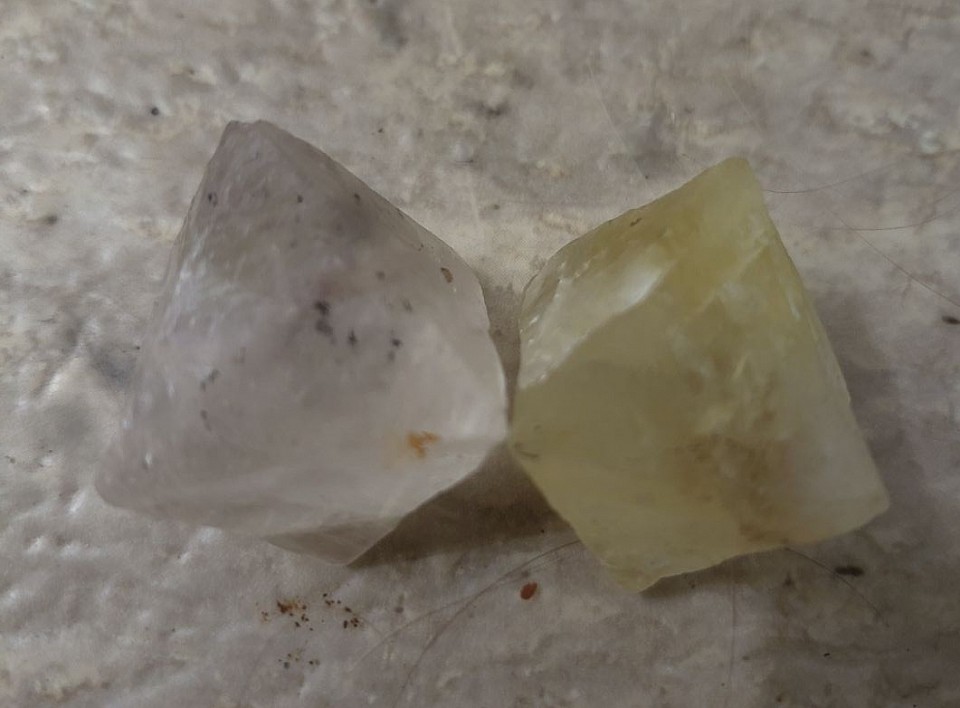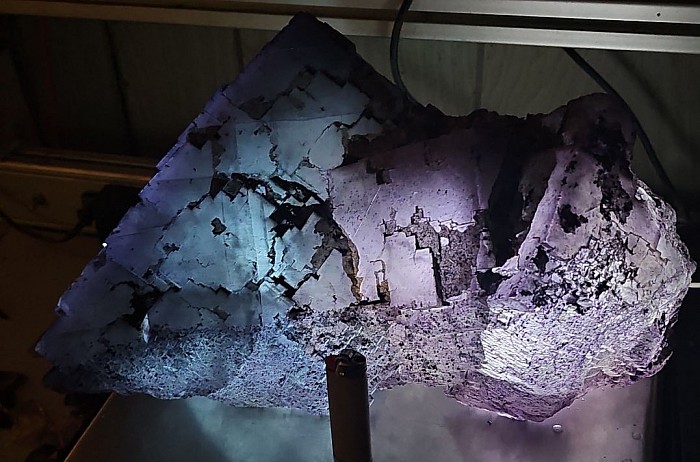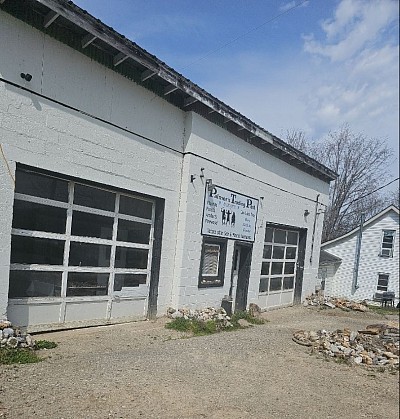Hardin County, IL. Fluorite
Hardin County Fluorite: Unveiling Nature’s Hidden Gems
Fluorite, also known as Fluorspar, is more than just a mineral—it’s a kaleidoscope of colors and geological wonder. As the official state mineral of Illinois, it holds a special place in the hearts of rockhounding enthusiasts. Let’s explore its beauty, properties, and where to find it in Hardin County.
Fluorite Properties
- Chemical Composition: Composed of calcium and fluorine (CaF₂)
- Color Spectrum: From deep purples and vibrant greens to crystal-clear and sunny yellows.
- Crystal Shapes: Cubes, octahedrons, and dodecahedrons—each a masterpiece of nature.
- Fluorescence: Some fluorite specimens glow under UV light, adding to their allure.
- Where to Seek Fluorite
Cave-in-Rock District
Located in Hardin County, this district boasts some of the world’s most exquisite fluorite specimens. Stratiform deposits (bedding plane deposits) make it a rockhound’s paradise. Dive into the rich mining history dating back to the 1840s.Educational experiences await guests at Cave-In-Rock Campground.
Rosiclare District
Another gem in Hardin County, the Rosiclare district offers pyrite, galena, and stunning fluorite crystals. Unearth hidden treasures as you explore.
Hardin County, Illinois -Fluorite
Come to A well-known destination for rockhounding enthusiasts, particularly those interested in fluorite, also known as fluorspar. This mineral, which is the state mineral of Illinois, is renowned for its vibrant colors and is a favorite among collectors.
Embarking on a rockhounding adventure in Hardin County, Illinois, is now more accessible than ever with the expert-guided tours offered by Hidden Gem Rockhounding services. .
Here's a detailed pricing guide for the various tours available:
**2-Hour Single Location Hunt**
- Ideal for beginners or those short on time.
- Focus on one specific area known for fluorite deposits.
- Price: $90 per person
**4-Hour Dual Location Hunt**
- A deeper dive into the geology of Hardin County.
- Visit two distinct locations with varied mineral specimens.
- Price: $150 per person
**8-Hour Quad Location Hunt**
- The ultimate rockhounding experience for enthusiasts.
- Explore four different locations, maximizing the chances of finding rare specimens.
- Price: $250 per person
All tours are conducted by knowledgeable local guides who are decendants of the original miners with a passion for geology and teaching. The prices include the use of necessary rockhounding equipment, educational materials, and transportation between the different sites within Hardin County.
**(Group discounts are available for parties of five or more, and special rates can be arranged for educational institutions and non-profit organizations looking to provide a unique field trip experience.)**
For those looking to turn their rockhounding journey into a vacation,
- Hidden Gem Rockhounding services offer package deals that include accommodations in partnership with local businesses.
To secure your spot on a tour and for more information on group rates and packages, please contact Hidden Gem Rockhounding services directly through their customer service portal.
Discover the hidden treasures of Hardin County with a guided rockhounding tour that promises not just a bag full of minerals but also a wealth of knowledge and memories to last a lifetime. Happy hunting!
Whether you're a beginner eager to learn the ropes or an experienced rockhound looking to expand your collection, these tours provide a comprehensive and educational experience tailored to your interests and schedule
The Need to Know Before-
- When planning a rockhounding trip to Hardin County, it's essential to know the best practices for locating, extracting, and cleaning fluorite, as well as understanding its value.
-
To find fluorite in Hardin County
, one should explore areas like the Cave-in-Rock district, which has a rich history of fluorite mining. Abandoned mines and surrounding areas can be fruitful, but always ensure you have permission to collect and are aware of the safety precautions. Once you've located fluorite, extracting it requires careful handling to prevent damage to the crystals. Tools such as chisels and hammers can be used, but it's crucial to chip away from the crystal to avoid fracturing it.
- Cleaning fluorite
can be challenging due to its sensitivity to temperature changes and chemicals. Simple methods like using a soft brush and water can be effective, but for more stubborn dirt, a solution of mild detergent can be used. Some collectors use a process called acid washing, but this should be done with caution and knowledge of proper handling and disposal of chemicals.
- The value of fluorite
varies based on several factors, including color, clarity, crystal habit, and the presence of zoning. Specimens with intense coloration and clear zoning patterns are particularly prized. Fluorite's value is also influenced by its uses in various industries, such as metallurgy, where it serves as a flux, and in optics, where it is used for lenses due to its low dispersion properties.
- In summary,
rockhounding for fluorite in Hardin County can be a rewarding experience for enthusiasts. With the right techniques for finding, extracting, and cleaning, along with an appreciation for the mineral's value and applications, collectors can enjoy the beauty and diversity of fluorite specimens from this region. Always remember to respect the environment and local regulations while engaging in this hobby, enjoy the beauty and diversity of fluorite specimens from this region. Always remember to respect the environment and local regulations while engaging in this hobby.
More Fluorite Information-
The history of fluorite mining in Hardin County, Illinois, is a fascinating journey that intertwines with the development of the region and the broader industrialization of the United States. Fluorite, also known as fluorspar, was initially considered a waste product until its significance in the steel industry was recognized in the late 19th century. The Rosiclare Lead and Fluorspar Mining Company, established near this site, became the first major producer of fluorite, marking the beginning of an era that would see Hardin County become home to some of the world's largest and deepest fluorite mines.
The mineral's colorful crystals formed over 150-200 million years ago, a testament to the geological transformations that shaped the earth's crust. Hot water, rich in fluorine and other minerals, was forced up through cracks, interacting with the calcium-rich limestone bedrock to create the stunning crystals known today. The mining of fluorite in Illinois began around 1842, and by the 1960s, the industry had reached its peak, with an average of 118,820 tons mined annually. This boom was driven by the mineral's utility as a flux in smelting metals and its later applications in optics and even everyday products like toothpaste.
However, the flourishing period of fluorite mining in Hardin County was not to last. The industry faced stiff competition from overseas producers, and the high costs associated with underground mining began to take their toll. By the mid-20th century, many of the mines, including the Crystal Mine in the Cave-In-Rock district, had ceased production. The specimens from these mines, particularly those displaying fluorescence under UV light, became rare and highly sought after by collectors.
The decline of the industry continued, and by 1995, the last mine in Illinois closed its doors, marking the end of an era. The cessation of mining activities in the United States meant that the once-thriving industry in Hardin County became a chapter in the history books. Today, the legacy of fluorite mining is preserved in museums and collections, where the vibrant crystals serve as a reminder of the region's past and the mineral's impact on the development of various industries.
In retrospect, the history of fluorite mining in Hardin County is not just about the extraction of a mineral; it's a narrative of human endeavor, economic shifts, and the relentless march of technology that eventually rendered local mining unprofitable. It's a story that mirrors the broader industrial narrative of the country, highlighting the rise and fall of industries as they adapt to global changes. The tales of these mines, the people who worked them, and the communities that grew around them continue to fascinate and educate those interested in the rich tapestry of America's industrial heritage.
The working conditions in the fluorite mines of Hardin County, Illinois, during their operation were typical of the mining industry of the time, which often meant they were harsh and potentially hazardous. Miners faced a variety of challenges underground, including the risk of cave-ins, flooding, and exposure to dust, which could lead to respiratory issues. The mines could be deep, with some reaching depths of 1,200 to 1,300 feet below the surface, which not only increased the physical demands on workers but also exposed them to significant temperature variations.
Safety measures in the early days of mining were minimal compared to modern standards, and the use of protective equipment was not as prevalent. Lighting was provided by carbide lamps, which, while effective, also posed a fire hazard in the presence of flammable gases. Ventilation systems were often inadequate, leading to poor air quality and the accumulation of harmful gases. The physical labor was intense, with miners using hand tools such as picks, shovels, and hammers to break apart the rock and extract the fluorite crystals. This manual labor was not only physically demanding but also required precision to avoid damaging the valuable crystals.
Despite the difficult conditions, the mining community in Hardin County was tight knit, with a strong sense of camaraderie among the workers. The miners were skilled laborers, many of whom had learned the trade from previous generations. They took pride in their work and the role they played in contributing to the region's economic prosperity. The mining companies provided employment opportunities that were vital to the local economy, and the towns that sprang up around the mines were vibrant communities with a shared identity rooted in the mining industry.
As technology advanced, some improvements were made to the working conditions in the mines. Mechanical drills and other equipment began to replace hand tools, increasing efficiency and reducing some of the physical strain on the miners. However, the introduction of machinery also brought new risks, including the potential for mechanical failures and accidents. The use of explosives for blasting rock introduced additional dangers, requiring careful handling and precise timing to prevent unintended consequences.
The end of fluorite mining in Hardin County came about not only due to economic factors, such as competition from overseas producers, but also because of the increasing awareness of the need for better working conditions and environmental considerations. The closure of the mines marked the end of an era, but the legacy of the miners and their contributions to the industry live on. Today, the history of fluorite mining in Hardin County is remembered and honored, with former miners and their families preserving the stories and artifacts of a time when the region was at the forefront of the fluorite mining industry. The experiences of those who worked in the mines serve as a reminder of the progress that has been made in mining safety and workers' rights, as well as the enduring human spirit that perseveres in the face of adversity.
More....
Palmer Trading Post
- Palmer's Trading Post is located at 590 N Canal St, Cave-in-Rock, IL, 62919.
- They are known for their selection of Hardin County Fluorite and Cave-In-Rock Fluorspar.
- The trading post has a 5.0 rating based on 21 reviews, indicating high customer satisfaction.
- Operating hours are from 12:00 to 16:00, Monday through Sunday.
- Palmer's Trading Post specializes in Hardin County Fluorite and Cave-In-Rock Fluorspar.
- They have teamed up with us at H.G.R.S. and now provide a list of rockhounding expert-guided rockhounding hunts.
- The trading post also offers a selection of related products for sale.
- For more detailed information on their offerings, it's best to contact them directly for any inquiries or to schedule a visit, they can be contacted at (618) 499-6607.or visit their Facebook page
Created By: Hidden Gem Rockhounding Services






